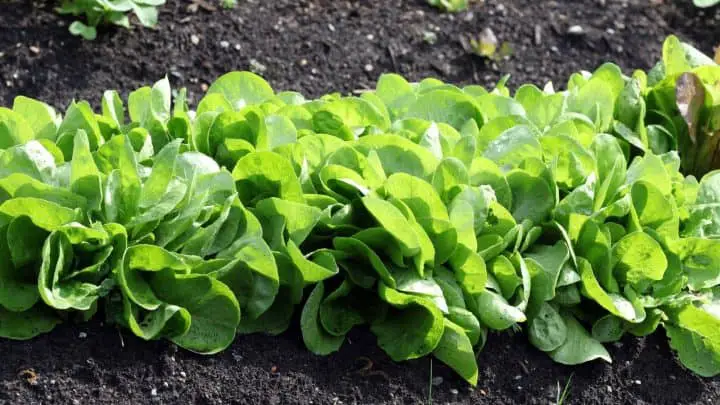How to Grow Lettuce in Hot Summer Temps

Summer is the time of year when you most want a salad… but also the time of year when it’s most difficult to grow heat-sensitive lettuce and other greens that aren’t bitter or bolting. What’s a hungry gardener to do?
This article will show you five easy-to-execute garden hacks to grow tender, tasty lettuce and greens even in the hottest summers:
- Provide shade,
- Harvest the leaves when they are small,
- Build your soil with organic matter to improve moisture retention and cool the roots,
- Water strategically
- Choose varieties of lettuce and greens that tolerate heat better
Ready to grow? Then read on!
Give it some shade
For humans, really hot days are often still somewhat nice in the shade–and lettuce feels the same way!
Even though a lettuce packet will often tell you that it likes full sun, and it certainly does in spring and fall, summer shade is the way to go, especially in the early afternoons when the sun is most intense.
How to make shade for lettuce in your garden? It’s simple and easy to accomplish in a few different ways:
- Build a frame (something as simple as bent branches will do) and spread shade cloth over the top
- Plant lettuce amongst taller, heat-loving vegetables like eggplant or peppers
- Create a “lettuce bed” in a shady spot in your yard (can be a pot too!)
Pair this hack with more frequent watering for overall cooler soil, and your lettuce will be considerably less likely to bolt or go bitter.
Harvest as baby greens
Another way to avoid ending up with a tough, un-tasty head of lettuce is simply to not let it get so big before you harvest.
Baby greens are easy and quick to grow–you can generally get a good harvest about two weeks from when you seed them–and they are a great leafy green for summer.
Not only can you sow and harvest in quick succession, but the small leaves are more tender and flavorful than older leafed-out whole heads of lettuce, which get a bit tough and bitter when they spend a long time growing in the heat.
You can also accomplish the same thing by harvesting the outer leaves of a lettuce head as they size up, and leaving the inside leaves to continue to grow.
For the best results, combine this with Tip #1 and sow baby greens in the shade.
Add organic matter to soil
Plant your summer lettuce in your richest garden soil. This will achieve three things:
- More organic matter will retain more water in the heat and create humidity on the ground.
- Ready access to rich soil will ensure that your lettuce and greens are not stressed for nutrients.
- The lettuce itself will uptake more nutrients, which are then passed on to you when you eat it!
You can add compost to the beds earlier in the season, or a few days before you plant your lettuce or greens.
Spread an even layer of compost one to two inches deep across the surface, then use a hula hoe or a hard rake to work it into the top few inches of soil. Don’t try to work it in too deeply; a fairly shallow layer up top will provide the benefits without breaking up the deeper soil structure.
Water in the morning and midday
In the hottest times of the year, your lettuce and greens will need extra water to keep their flavor from becoming bitter from wilting.
The best times to water lettuce, greens, and other vegetables in the heat of summer are in the morning and another watering in the middle of the day between noon and one p.m.
The early morning watering provides them with good hydration right from the beginning of the day, and the midday watering cools both the soil and the leaf tissues right when the temperatures are at their most severe, buffering them from its worst effects.
Choose heat-tolerant lettuce varieties
There are also varieties of lettuce on the market that are more tolerant of heat than others. Oakleaf lettuce in particular is known for good heat tolerance, and often grown by gardeners in the hot, humid Southern US. Green-leafed lettuce also usually performs better in the heat than red-leafed lettuce.
When it comes to greens, avoid growing spinach or kale in midsummer–even heat-tolerant varieties of these plants tend to bolt and offer sub-par flavor. Try collards, amaranth, and mustards instead: these greens thrive in high heat and long days without developing a bitter flavor.
Here are our recommendations for heat-tolerant lettuce and leafy green varieties:
Lettuce:
- ‘Black Seeded Simpson’ (Leaf Lettuce)
- ‘Great Lakes 118’ (Crisphead)
- ‘Ice Queen (Reine des Glaces)’ (Summer Crisp)
- ‘Little Gem’ (Romaine)
- ‘Marvel of Four Season’ (Butterhead)
- ‘Parris Island’ Cos (Romaine)
- ‘Red Sails (Leaf Lettuce)
- ‘Rouge d’ Hiver’ (Romaine)
- Salad Bowl Blend (Leaf Lettuce)
Leafy greens: